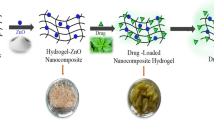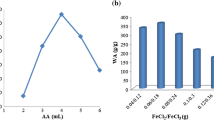Abstract
Basil seed with mucilage shell contains carbohydrates (BSG) which can be extracted to produce natural hydrogel compatible with the human body. In this study, a magnetic natural hydrogel was synthesized by copolymerization between the double bonds of vinyl-modified Fe3O4/SiO2 nanoparticles, methacrylic acid (MA) as a monomer, ethylene glycol dimethacrylate (EGDMA) as a crosslinker monomer, and vinylated BSG through free radical addition polymerization for delivery of naproxen (NPX) as a model drug. The product of each reaction step was identified by FTIR technique and the morphology of nanoparticles and magnetic nano-hydrogels was investigated using the SEM technique. SEM image analysis of dry magnetic hydrogels shows the existence of a porous structure with pore size in the range of 100–300 nm. The porosity of the hydrogels used in drug delivery systems can be useful in producing a large surface area, enhancing water absorption, and facilitating drug release. The swelling behavior of nano-hydrogels, a significant feature for drug delivery systems, was investigated at different pHs in buffer solutions. Also, drug loading and delivery experiments were performed by monitoring the concentration of loaded and released NPX by absorption at 245 nm on a UV–Vis spectrophotometer. The cumulative release behavior of hydrogels was investigated and the in vitro NPX release was achieved in the range of 98% at pH 7.4 after 24 h.






Similar content being viewed by others
References
Ahmed EM (2015) Hydrogel: preparation, characterization, and applications: A review. J Adv Res 6:105–121
Ahmed EM, Aggor FS, Awad AM, El-Aref AT (2013) An innovative method for preparation of nanometal hydroxide superabsorbent hydrogel. CarbohydrPolym 91:693–698
Zhao W, Jin X, Cong Y, Liu Y, Fu J (2013) Degradable natural polymer hydrogels for articular cartilage tissue engineering. J Chem TechnolBiotechnol 88:327–339
Li Y, Huang G, Zhang X, Li B, Chen Y, Lu T, Lu TJ, Xu F (2013) Magnetic hydrogels and their potential biomedical applications. AdvFunct Mater 23:660–672
Sabbagh F, Kiarostami K, MahmoudiKhatir N, Rezania S, Muhamad II (2020) Green synthesis of Mg0.99Zn0.01O nanoparticles for the fabrication of κ-carrageenan/NaCMC hydrogel in order to deliver Catechin. Polymers 12:861
Sionkowska A, Gadomska M, Musiał K, Piatek J (2020) Hyaluronic acid as a component of natural polymer blends for biomedical applications: a review. Molecules 25:4035–4052
Beaune G, Menager C (2010) In situ precipitation of magnetic fluid encapsulated in giant liposomes. J Colloid Interface Sci 343:396–399
Ajinkya N, Yu X, Kaithal P, Luo H, Somani P, Ramakrishna S (2020) Magnetic iron oxide nanoparticle (IONP) synthesis to applications: present and future. Materials 13:4644–4679
Medeiros SF, Santos AM, Fessi H, Elaissari A (2011) Stimuli-responsive magnetic particles for biomedical applications. Int J Pharm 403:139–163
Bashir S, Hina M, Iqbal J, Rajpar H, Mujtaba MA, Alghamdi NA, Wageh S, Ramesh K, Ramesh S (2020) Recent progress of polysaccharide-based hydrogel interfaces for wound healing and tissue engineering. Polymers 12:2702–2762
Laurent S, Bridot JL, Muller RN (2010) Magnetic iron oxide nanoparticles for biomedical applications. Future Med Chem 2:427–449
Hu X, Wang Y, Zhang L, Xu M, Zhang J, Dong W (2018) Design of a pH-sensitive magnetic composite hydrogel based on salecan graft copolymer and Fe3O4@SiO2 nanoparticles as drug carrier. Int J Biol Macromol 107:1811–1820
Jeddi MK, Mahkam M (2019) Magnetic nano carboxymethyl cellulose-alginate/chitosan hydrogel beads as biodegradable devices for controlled drug delivery. Int J BiolMacromol 135:829–838
HayatiM RG, Ramezani M, Hosseini SS, Mizani F (2020) Temperature/pH/magnetic triple-sensitive nanogel–hydrogel nanocomposite for release of anticancer drug. Polym Int 69:156–164
Ghorpade VS, Yadav AV, Dias RJ, Mali KK (2018) Fabrication of citric acid crosslinked β-cyclodextrin/hydroxyethylcellulose hydrogel films for controlled delivery of poorly soluble drugs. J ApplPolym Sci 135:46452–46464
Barbucci R, Pasqui D, Giani G, de Cagna M, Fini M, Giardino R, Atrei A (2011) A novel strategy for engineering hydrogels with ferromagnetic nanoparticles as crosslinkers of the polymer chains. Potential applications as a targeted drug delivery system. Soft Matter 7:5558–5565
Zhanga M, Wana Y, Wenb Y, Lia C, Kanwala A (2020) A novel poly(vinylalcohol)/carboxymethyl cellulose/yeast double degradable hydrogel with yeast foaming and double degradable property. Ecotox Environ Safe 187:109765
Song K, Zhu W, Li X, Yu Z (2020) A novel mechanical robust, self-healing and shape memory hydrogel based on PVA reinforced by cellulose nanocrystal. Mater Lett 260:126884
Farahmandfar R, Asnaashari M, Salahi MR, Khosravi Rad T (2017) Effects of basil seed gum, Cress seed gum and Quince seed gum on the physical, textural and rheological properties of whipped cream. Int J Biol Macromol 98:820–828
Razavi SMA, Mortazavi SA, Matia-Merino L, Hosseini-Parvar SH, Motamedzadegan A, Khanipour E (2009) Optimisation study of gum extraction from Basil seeds (Ocimumbasilicum L). Int J Food Sci Technol 44:1755–1762
Anjaneyalu YV, Channe G (1979) Structural studies of an acidic polysaccharide from Ocimumbasilicum seeds. Carbohydr Res 75:251–256
Anjaneyalu YV, Tharanathan RN (1971) Composition and preliminary fractionation of the seed mucilage of Ocimumcanum. Aust J Chem 24:1501–1507
Naji-Tabasi S, Razavi SMA, Mohebbi M, Malaekeh-Nikouei B (2016) New studies on basil (Ocimumbacilicum L.) seed gum: Part I- fractionation, physicochemical and surface activity characterization. Food Hydrocoll 52:350–358
Zang L, Liu Y, Chen Z, Liu P (2016) Behavior and mechanism of ultralow friction of basil seed gel. Colloids Surf A PhysicochemEng Asp 489:454–460
HashemiGahruie H, Ziaee E, Eskandari MH, Hosseini SMH (2017) Characterization of basil seed gum-based edible films incorporated with Zatariamultiflora essential oil nanoemulsion. CarbohydrPolym 166:93–103
Liao J, Huang H (2020) Review on magnetic natural polymer constructed hydrogels as vehicles for drug delivery. Biomacromol 21:2574–2594
Sarioglu E, Kocaaga BA, Turan D, Batirel S (2019) Theophylline-loaded pectin-based hydrogels. II. effect of concentration of initial pectin solution, crosslinker type and cation concentration of external solution on drug release profile. J ApplPolym Sci 136:48155–18160
Azmeera V, Tungala K, Adhikary P, Kumar K, Krishnamoorthi S (2017) Synthesis of β-cyclodextrin grafted polyacrylamide: water treatment and In-vitro drug release study. Int J Biol Macromol 104:1204–1211
Li X, Qin H, Zhang X, Guo Z (2019) Triple-network hydrogels with high strength, low friction and self-healing by chemical-physical crosslinking. J Colloid Interface Sci 556:549
Apryatina KV, Tkachuk EK, Smirnova LA (2020) Influence of macromolecules conformation of chitosan on its graft polymerization with vinyl monomers and the copolymer properties. CarbohydrPolym 235:115954
Hu X, Wang Y, Zhang L, Xu M, Zhang J, Dong W (2018) Design of a pH-sensitive magnetic composite hydrogel based on salecan graft copolymer and Fe3O4@SiO2 nanoparticles as drug carrier. Int J Biol Macromol B 107:1811–1820
Fan JP, Xu XK, Xu R, Zhang XH, Zhu JH (2015) Preparation and characterization of molecular imprinted polymer functionalized with core/shell magnetic particles (Fe3O4@SiO2@MIP) for the simultaneous recognition and enrichment of four taxoids in Taxus × media. Chem Eng J 279:567–577
Huang X, Wang G, Yang M, Gou W, Gao H (2011) Synthesis of polyaniline- modified Fe3O4/SiO2/TiO2 composite microspheres and their photocatalitic application. Mater Lett 65:2887–2890
Anirudhan TS, Rejeena SR, Binusree J (2013) Adsorptive separation of myoglobin from aqueous solutions using iron oxide magnetic nanoparticles modified with functionalized nanocrystalline cellulose. J Chem Eng Data 58:1329–1339
Naji-Tabasia S, Razavi SMA, Mehditabar H (2017) Fabrication of basil seed gum nanoparticles as a novel oral delivery system of glutathione. CarbohydrPolym 157:1703–1713
Soleimani F, Sadeghi H, Shahsavari H, Soleimani A, Sadeghi F (2013) Drug release study from superabsorbent hydrogel based on poly-2-acrylamido-2-methylpropanesulfonic acid grafted collagen. Asian J Chem 25:4619–4623
Kono H, Teshirogi T (2015) Cyclodextrin-grafted chitosan hydrogels for controlled drug deliver. Int J Biol Macromol 72:299–308
Nezami S, Sadeghi M, Mohajerani H (2020) A novel pH-sensitive and magnetic starch-based nanocomposite hydrogel as a controlled drug delivery system for wound healing. PolymDegrad Stab 179:109255
Author information
Authors and Affiliations
Corresponding author
Rights and permissions
About this article
Cite this article
Sanaei Moghaddam Sabzevar, Z., Mehrshad, M. & Naimipour, M. A biological magnetic nano-hydrogel based on basil seed mucilage: study of swelling ratio and drug delivery . Iran Polym J 30, 485–493 (2021). https://doi.org/10.1007/s13726-021-00905-0
Received:
Accepted:
Published:
Issue Date:
DOI: https://doi.org/10.1007/s13726-021-00905-0




